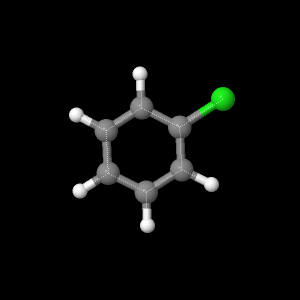Once the molecule file is fully loaded, the image at right will become live. At that time the "activate 3-D" icon
![]()
will disappear.
The ab initio and MOPAC geometry optimizations are shown below for
the aromatic molecule, chlorobezene. The literature values found for
the bond angles were 121.7 degrees for angle <CC(Cl)C and 120 degrees
for angle <CC(H)C. For bond lengths the experimental literature
values were found to be .1400nm for C=C, 0.1737nm C-Cl and 0.1083nm for
C-H.
The bond lengths and angles found using the
most optimized geometry for MOPAC are represented by the buttons above.
The bond lengths and angles found using the most
optimized geometry for ab initio are represent by the buttons above. AM1
was found to be the most accurate optimized geometry out of all of our
theories used for calculating bond lengths and 6-31G was found to be the
most accurate optimized geometry for the bond angles. The percent error
found between the calculated bond lengths and
the experimental literature was found to be 0.71% for C=C, 2.13% for
C-Cl, and 1.57% C-H.
The electrostatic potential of chlorobenzene can be
seen by clicking the button above. The highest electrostatic potential
is represented by the color blue and the lowest electrostatic potential
is represented with the color red.
The partial atomic charges of chlorobenzene are
labelled on each atom and can be seen by clicking the button above.
Partial charges occur when there is an uneven distribution of electrons due to the symmetry of the molecule.
The highest occupied molecular orbit (HOMO) was calculated by summing
the total electrons and dividing by two. The 29th orbital in this case
is the highest occupied molecular orbit.
The lowest occupied molecular orbit (LUMO) was calculated by summing
the total electrons and dividing by two. The 30th orbital in this case
is the lowest occupied molecular orbit.
UV-Vis Cis Transitoin Dipole Moments
UV-Vis transition calculations for cis transition
dipole moments were calculated with GamessQ using our best optimized
geometry, DZV, represented in Table 1.
Table 1.
Transition
|
DZV (nm)
|
G-1
|
196.597
|
G-2
|
190.430
|
G-3
|
163.663
|
G-4
|
148.538
|
G-5
|
147.393
|
G-6
|
136.740
|
G-7
|
142.329
|
G-8
|
131.139
|
G-9
|
127.391
|
G-10
|
127.008
|
UV-Vis. literature values were found for the important peaks of
chlorobenzene in the CRC handbook, represented in Table 2. We found that
the wavelengths from the literature value were a lot higher than
the calculated wavelengths. The wavelengths found for the experimental
and literature did not show any type of correlation between one another.
Table 2.
Wavelength (nm)
|
Max Absorbance
|
287
|
1.000
|
300
|
0.050
|
325
|
0.040
|
350
|
0.020
|
400
|
0.005
|
Based on template by A. Herráez as modified by J. Gutow
Using directory /Users/student/Documents/Dasan and Lauren/Website Folder Dasan and Lauren/Chlorobenzene Web Info
adding JmolPopIn.js
...jmolApplet0
...adding Chlorobenzene_AM1_Bond_Lengths.png
copying and unzipping jsmol.zip directory into /Users/student/Documents/Dasan and Lauren/Website Folder Dasan and Lauren/Chlorobenzene Web Info
...copying
file:/Users/student/Documents/Dasan and Lauren/GamessQ dasan lauren/Chlorobenzene_AM1.log
to
/Users/student/Documents/Dasan and Lauren/Website Folder Dasan and Lauren/Chlorobenzene Web Info/Chlorobenzene_AM1.log
...adding Chlorobenzene_AM1_Bond_Lengths.spt
...jmolApplet1
...adding Chlorobenzene_AM1_Bond_Angles.png
copying and unzipping jsmol.zip directory into /Users/student/Documents/Dasan and Lauren/Website Folder Dasan and Lauren/Chlorobenzene Web Info
...adding Chlorobenzene_AM1_Bond_Angles.spt
...jmolApplet2
...adding Chlorobenzene_PM3_Bond_Lengths.png
copying and unzipping jsmol.zip directory into /Users/student/Documents/Dasan and Lauren/Website Folder Dasan and Lauren/Chlorobenzene Web Info
...copying
file:/Users/student/Documents/Dasan and Lauren/GamessQ dasan lauren/Chlorobenzene_PM3.log
to
/Users/student/Documents/Dasan and Lauren/Website Folder Dasan and Lauren/Chlorobenzene Web Info/Chlorobenzene_PM3.log
...adding Chlorobenzene_PM3_Bond_Lengths.spt
...jmolApplet3
...adding Chlorobenzene_PM3_Bond_Angles.png
copying and unzipping jsmol.zip directory into /Users/student/Documents/Dasan and Lauren/Website Folder Dasan and Lauren/Chlorobenzene Web Info
...adding Chlorobenzene_PM3_Bond_Angles.spt
...jmolApplet4
...adding Chlorobenzene_6-21G_Bond_Lengths.png
copying and unzipping jsmol.zip directory into /Users/student/Documents/Dasan and Lauren/Website Folder Dasan and Lauren/Chlorobenzene Web Info
...copying
file:/Users/student/Documents/Dasan and Lauren/GamessQ dasan lauren/Chlorobenzene_621G.log
to
...compressing large data file to
/Users/student/Documents/Dasan and Lauren/Website Folder Dasan and Lauren/Chlorobenzene Web Info/Chlorobenzene_621G.log.gz
/Users/student/Documents/Dasan and Lauren/Website Folder Dasan and Lauren/Chlorobenzene Web Info/Chlorobenzene_621G.log.gz
...adding Chlorobenzene_6-21G_Bond_Lengths.spt
...jmolApplet5
...adding Chlorobenzene_6-21G_Bond_Angles.png
copying and unzipping jsmol.zip directory into /Users/student/Documents/Dasan and Lauren/Website Folder Dasan and Lauren/Chlorobenzene Web Info
...adding Chlorobenzene_6-21G_Bond_Angles.spt
...jmolApplet6
...adding Chlorobenzene_6-31G_Bond_Lengths.png
copying and unzipping jsmol.zip directory into /Users/student/Documents/Dasan and Lauren/Website Folder Dasan and Lauren/Chlorobenzene Web Info
...copying
file:/Users/student/Documents/Dasan and Lauren/GamessQ dasan lauren/Chlorobenzene_631G.log
to
...compressing large data file to
/Users/student/Documents/Dasan and Lauren/Website Folder Dasan and Lauren/Chlorobenzene Web Info/Chlorobenzene_631G.log.gz
/Users/student/Documents/Dasan and Lauren/Website Folder Dasan and Lauren/Chlorobenzene Web Info/Chlorobenzene_631G.log.gz
...adding Chlorobenzene_6-31G_Bond_Lengths.spt
...jmolApplet7
...adding Chlorobenzene_6-31G_Bond_Angles.png
copying and unzipping jsmol.zip directory into /Users/student/Documents/Dasan and Lauren/Website Folder Dasan and Lauren/Chlorobenzene Web Info
...adding Chlorobenzene_6-31G_Bond_Angles.spt
...jmolApplet8
...adding Chlorobenzene_DZV_Bond_Lengths.png
copying and unzipping jsmol.zip directory into /Users/student/Documents/Dasan and Lauren/Website Folder Dasan and Lauren/Chlorobenzene Web Info
...copying
file:/Users/student/Documents/Dasan and Lauren/GamessQ dasan lauren/Chlorobenzene_DZV.log
to
...compressing large data file to
/Users/student/Documents/Dasan and Lauren/Website Folder Dasan and Lauren/Chlorobenzene Web Info/Chlorobenzene_DZV.log.gz
/Users/student/Documents/Dasan and Lauren/Website Folder Dasan and Lauren/Chlorobenzene Web Info/Chlorobenzene_DZV.log.gz
...adding Chlorobenzene_DZV_Bond_Lengths.spt
...jmolApplet9
...adding Chlorobenzene_DZV_Bond_Angles.png
copying and unzipping jsmol.zip directory into /Users/student/Documents/Dasan and Lauren/Website Folder Dasan and Lauren/Chlorobenzene Web Info
...adding Chlorobenzene_DZV_Bond_Angles.spt
...jmolApplet10
...adding Chlorobenzene_Electrostatic_Potential.png
copying and unzipping jsmol.zip directory into /Users/student/Documents/Dasan and Lauren/Website Folder Dasan and Lauren/Chlorobenzene Web Info
...adding Chlorobenzene_Electrostatic_Potential.spt
...jmolApplet11
...adding Chlorobenzene_Partial_Atomic_Charges.png
copying and unzipping jsmol.zip directory into /Users/student/Documents/Dasan and Lauren/Website Folder Dasan and Lauren/Chlorobenzene Web Info
...adding Chlorobenzene_Partial_Atomic_Charges.spt
...jmolApplet12
...adding Chlorobenzene_HOMO.png
copying and unzipping jsmol.zip directory into /Users/student/Documents/Dasan and Lauren/Website Folder Dasan and Lauren/Chlorobenzene Web Info
...adding Chlorobenzene_HOMO.spt
...jmolApplet13
...adding Chlorobenzene_LUMO.png
copying and unzipping jsmol.zip directory into /Users/student/Documents/Dasan and Lauren/Website Folder Dasan and Lauren/Chlorobenzene Web Info
...adding Chlorobenzene_LUMO.spt
![]() will disappear.
will disappear.
